
Helleborus x hybridus
Breeding for color , doubling and other features .update 03/08
introduction
Twenty years ago , let's say before 1990 , Hellebore was not known over here .Well not really , some gardeners had rather a bad experience with H.niger but the price was low and the plants could be replaced almost every two years .
Others had a H. foetidus in the garden found somewhere in the country in the wild or brought as seed from a journey abroad . In 1980 , I brought seeds from the border of Spain/France . It was a H.foetidus with red nosed flowers , the plant survived for a while in my garden in Brussels and I got seedlings , so it became a lasting pleasure .
Not to forget the H. viridis , a medicinal plant , found all over Europe and used against worms . A horse drug .
Perhaps by exception some other wild forms .
As a H. orientalis orientalis with White flowers . A gardener gave me a cutting and told me she had the plant for a very long time in her garden , 30 years ore even more , a cutting or a present from .....
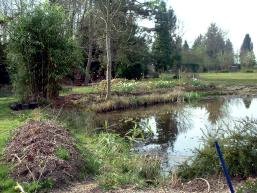 Mid nineties we came to our new home , between Brussels and Leuven ( university Belgium ) , with a large garden ; there are big trees , oak , beech etc.
and a natural pond . The soil is heavy with clay and contains limestone and iron . ( zone 8 )
Mid nineties we came to our new home , between Brussels and Leuven ( university Belgium ) , with a large garden ; there are big trees , oak , beech etc.
and a natural pond . The soil is heavy with clay and contains limestone and iron . ( zone 8 )It was also the moment I got a present from the family ; a Hellebore in flower of color Rose . Unknown to me but in love at once !
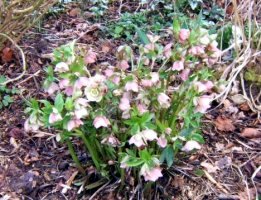 The first year I collected several seeds and I did what every gardener would do , put them in a dry place and sew them in spring the year after .
A small number of seedlings popped up but the bulk came at the very end of the year and even at the beginning of the next year .
The first year I collected several seeds and I did what every gardener would do , put them in a dry place and sew them in spring the year after .
A small number of seedlings popped up but the bulk came at the very end of the year and even at the beginning of the next year .Even two years later I got seedlings .
The first flowers came up at the same moment , heartbreaking greens and whites .
Update 03/08
The name " my Queen Mother " (mQM) was given to my first Hellebore and used in the experiment .
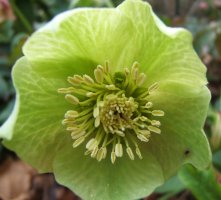
All this was triggering , so I bought the book written by Strangeman and Rice , and I understood that I could do better ; sow the seeds almost after collecting !!
And this is possible even without an indoor protection !!
Now I started browsing for the subject and found a lot of places to be . On the English Web places I learned the word "Strain" as if it would be possible to get seeds almost 100% true breeding for color .
Why not ? But is this true for the color Rose ? Not what I saw or found in the book .
publications
In fact it was not possible to find good information on the subject . There are scientific papers concerning H niger and H foetidus mostly because of their medicinal interestVery interesting was a paper on the functionality of plastids in the sepals of H niger ;
In short : those plastids take over the feeding of the ripening seeds while the old leaves died off and the young leaves are not formed .
Nothing about hybridus or species involved in the hybridus .
By surprise I found two papers from Mr Ben Zonneveld who was so kind to send me a copy ;
In short: He measured the density (weight ) of the chromosomes of almost all hellebore species ( and Hosta ) and found differences according to the places where they do come from
Most interesting for the species involved in the H x hybridus , gardeners may call them the Orientalis-group .
The articles influenced me , but I'm the only responsible for my interpretations .
Several years ago I wrote some texts ( not articles ) on my observations on color-breeding with Hellebore x hybridus . And as I could send those texts to a number of persons , I got by moments very kind and interesting reactions .
This brought me to the idea to mix up what I know in this larger text ,not as a final note , but rather as a report of what I could collect until now . For the sake of easy reading I'll not repeat in the text that in general I'm dealing with hypothesis and suppositions .
Starting the experiment
Just know that I have experimented with roses , very complicated genetics , and Hosta with colored leaves .A lot of information can be found in books and even on the Internet about those species as they are plants of big commercial interest .
My formation , say mathematics or statistics , has nothing to do with biology nor genetics , but with an effort I can understand a lot of their methods .
It is possible for me to set up a scientific breeding experiment but for the moment I prefer to wait until there are valuable indications on the subject , so we can really breed then for it under severe conditions .
Experimenting with plants is a kind of hobby , how to propagate was always a thriving question for me .
The step to go for Hellebore color was not big , the problem to develop has to do with genetics .
The best way to find out the genetic content of a plant is to use the selfing method , I learned tough .
 Selfing means the use of the sex-cells of the same plant ,female pods and male pollen , and preventing cells , in this case pollen from other
hellebore coming in .
Selfing means the use of the sex-cells of the same plant ,female pods and male pollen , and preventing cells , in this case pollen from other
hellebore coming in . But in my case there were no other hellebore in the neighborhood so the bumblebees would not disturb my experiment . Fertilizing Hellebore is very easy , I use the nose to nose method ; just take two flowers , bring them together and imitate gentle kisses .
With the naked eye you'll see the yellow pollen on the pods , and most important you'll notice the pods swelling within 24 hours ,also the pods contain in general more seeds than those fertilized (pollinated) by the bees .
The Results ? Be patient ,
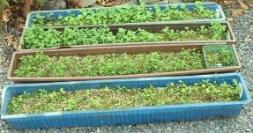 After collecting the seeds ( from March on ) , sowing ( July ) , popping up seedlings as cress ( December , January next year ) and potting up in
individual square 9 cm pots ( from April on ) , repotting in 1,5 l pots ( a year later ) ,
After collecting the seeds ( from March on ) , sowing ( July ) , popping up seedlings as cress ( December , January next year ) and potting up in
individual square 9 cm pots ( from April on ) , repotting in 1,5 l pots ( a year later ) ,I had to wait at least three years to have an overview on the results , 80 flowering plants .
There was no visible relation between color and other traits . In fact , the leaves , the nectaries , the shape of the sepals and other features in this flowering collection , also called F1 seedlings , was rather uniform .
Now we could concentrate on the color and make some assumptions :
- The original color for the flowers of the mother was unspotted Rose , now we see Green , White , 3 different tones of Rose and Very Dark ( not black see later )
assumption 1 : there is a gen for White ( W ) and a co-dominant gen for dark Rose ( R ) ( allele is the correct word )
- we see also different Green flowers ; pure Green , Green with the outer side of the flower dark Rose
assumption 2 : Green means there is no gen for color present ( - ) ( no allelic value )
- except for the Very Dark ( not black see later ) , 15 % of the flowers was spotted in different intensities while the mother was not
assumption 3 : Spots do not influence the color , their origin is from plastids and possibly not under ( the same ) genetic control .
Count and compare with a model
Counting hellebore colors is triggering because the color is influenced by the day length and temperature .The year I counted , I remember , it was possible until 15 January . From then on we got a cold spot and all the flowers containing at least one gen for dark Rose became darker until they all became very dark .
The best match was found for a two gen pair model ( Punett square 4 allele ; R - W - ) under
assumption 4 : garden Hellebore are diploid ( not really an assumption , I could not find better )
A discussion on color name and determination
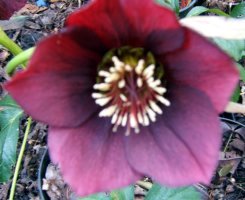 For personal use the correct name of the color is not important , but becomes a problem when you want to communicate with others .
For personal use the correct name of the color is not important , but becomes a problem when you want to communicate with others .What I call Rose might be called Pink by others and light and dark pink still stands , the problem arises with what I call " Very Dark " . The closest color in my garden comes from a Blue Lady that I bought , very beautiful but not blue please ! (see picture --> )
Brownish-purple is perhaps too complicated and noncommercial but acceptable in a breeding context ?
My concern for colors has not only to do with correct figures when I count the flowering seedlings , but also because I want to go on with the experiment in a slightly different way , and avoid a second selfing which is time consuming and weakens up the plants .
The seedlings ( F1) are put together by color on different locations in the garden and their seedlings ( F2 ) will perhaps confirm or not the proposed model .
The year after I had to correct and put two Whites with the light Rose and one Rose with the spotted Rose , not too bad I think and without influence on the suggested model .
Here I come back to the " Very Dark , not black " or Brownish-purple ; ( probably R R R - or R R R R ) None of them are really spotted but some are what I call marbled , the spots if ever present have a finer texture .
Most important is that those flowers turn to green when fertilized as most hellebore flowers do . The unmarbled keep color even after drying , a joy for flower-pressers .
The experiment goes on
For the moment , November 2006 , it is impossible to count the ( F2 ). Some seedlings are in flower but still out of date , it is to warm and almost all colors are pale even those that I labeled dark last year .A small number of seedlings was in flower last year , so I can give the following indications :
The seedlings (F2) from :
- The Very Dark ( F1 ), unmarbled , have different tones of Very Dark and a small number are pure Green or heavy spotted dark Rose ( on 25 seedlings )
- The Rose ( F1 ) have slightly more pale or light colors but I must always wait another year for the majority of the darker tones as they flower in general a year later.
- The unspotted whites ( F1 ) are mostly white and a small number are of light rose , some are spotted
- The same for the spotted whites ( F1 ) but more seedlings are spotted .
- The green test was not executed but replaced by a yellow test .
Update 03/08
- The seedlings (F2) from a mother of color Rose (F1) give the same result as we could observe for the seedlings (F1) coming from the original mother (mQM) of color Rose , the same segregation for color .- Spotted parents give more spotted children but there is always a number unspotted under the seedlings .
- (Inbreeding) Crosses of Very Dark always give a small number of Green flowers and also some of the three different tones of color Rose , but mostly the darker tone . Even a pure white here and there is not impossible .
- Almost the same can be told for crosses from White parents but here apart from the Greens we also have a small number of light Rose and an even smaller number of "normal" Rose .
- Until now the seedlings from the Yellows contain a lot of Greens , some whites but no gen for Rose came in . Apparently good Yellows have also a gen for White
The presence of Green in all the different seedlings is very triggering , the other colors are probably coming in with the bees as I did not protect my crosses .
End update 03/08
Linkage
My F2 seedlings ( the daughters of the daughters of the mother ) are confirming some characteristics . It is exiting to see the form and shape of the leaves becoming different according to the color . It might be a regression to the wild form but the flowers keep their high quality .Another important observation or even confirmation is that the paler flowers are on bigger plants and that those plants have a tendency to flower earlier in the year , before December , and some of them flower twice a year especially the Whites .
The darker tones give smaller plants and flower after January , the seedlings mostly flower only after three years for the first time .
The exception are the marbled Very Dark , the plants become also big and their flowering period is rather normal . So wait for a conclusion .
Update 03/08
Still correct for the mQM seedlings but other parents came in , so it is no longer correct for the whole collection .End update 03/08
Spots
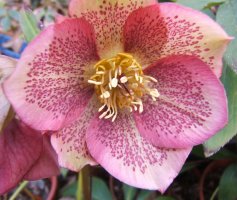 According to information I got from other breeder , unspotted parents can give up to 20% spotted seedlings and spotted parents may give
10% unspotted seedlings . My experiment confirms that you can become unspotted flowers from spotted parents .
According to information I got from other breeder , unspotted parents can give up to 20% spotted seedlings and spotted parents may give
10% unspotted seedlings . My experiment confirms that you can become unspotted flowers from spotted parents . Update 03/08
Spots are not dominant but difficult to avoid them .
Some respected people think the spots and the color in general has to do with anthocyanins , a natural color mostly under genetic control .
By observation , I can see that the color in general and the spots change under climatic conditions much more dramatically as for example with roses .
For the moment I'm more convinced that this effect results from the presence of plastids , the same particles turning your potatoes or carrots blue when they grow out of the soil . Plastids can have a lot of colors .
Plastids are small particles "living" in a cell and having their own genetic material, they are transferred to the daughter-seedling mostly by the mother but a paternal transfer is also possible . Their number can be very high and perhaps explain the " distribution"-effect . The cooperation with a normal gen is possible but not necessary by the transfer .
Yellow , Red and the Black tones are probably more under plastid influence than under normal genetic control . Triggering is the following information ; It seems impossible to get from the most yellow or heaviest black better seedlings . There is a "corrector" at work ?
The presence of plastids in plants has probably to do with the origins of life where single cells became symbiotic organisms and could develop to higher forms of life .
The presence and activity has been proven for Hellebore niger . The fact that one can cut the old leaves of a Hellebore x hybridus and still get flowers and ripening seeds might be an indication of the presence of active plastids .
It would be unfair not to mention that adult hybridus plants mostly have a well developed rhizome ( thick deformed roots ) which also explains their ability to recover after a very dry period .
Doubling
In my collection I did not have doubles . I only had a White flowering plant with deformed nectaries and this deformation is influenced by climatic conditions .Update 03/08
The name " my White Lady " (mWL) was given and an experiment started
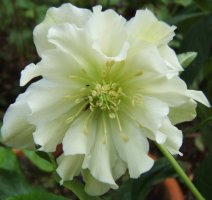 One year there is almost no deformation , the other year up to 20% of the nectaries have a small " flag " with the same color of the sepals . I selfed the plant and
for the moment I could harvest three real big doubles , roughly estimated as one seedling pro fifty or 2% .
One year there is almost no deformation , the other year up to 20% of the nectaries have a small " flag " with the same color of the sepals . I selfed the plant and
for the moment I could harvest three real big doubles , roughly estimated as one seedling pro fifty or 2% .Normally the nectaries fall off when the flower has been fertilized , in this case the "petals" are mostly kept on the flower for a long time . Some seedlings have also deformed nectaries , the Whites , none are anemonoid
Written end 2006 , see correction under the following heading " deformed and anemone forms "
There must be different types of doubling , deformation of the nectaries or doubling of the sepals or both , but it seems normal that double parents always give a small amount of singles .
If we assume that for doubling we need at least two gene pairs , we become with the preceding information a strong indication that we have to do with random segregation ( to a certain extend ) .
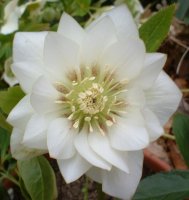 Not impossible , the genes are most likely on the same chromosome , so one of the gene pairs is on a greater distance from the node ( centromere ) ,and
the possibility to get a cross-over becomes bigger with the distance .
Not impossible , the genes are most likely on the same chromosome , so one of the gene pairs is on a greater distance from the node ( centromere ) ,and
the possibility to get a cross-over becomes bigger with the distance . The climatic influence on this random segregation is a question for specialists , nevertheless the observations go into this direction .
If this random segregation is also present for color , why not , it becomes rather difficult to get 100% color strains .
At last , I assume that the deformed nectaries prove the presence of genes for doubling but in some cases it seems that some of these plants never give double seedlings .
May we assume that the random segregation is also plant dependent , or is this information coming from a hardier climatic zone ?
deformed and anemone forms
Update 03/08
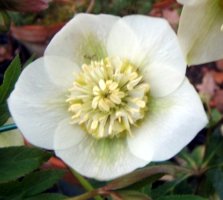 Now I'm able to add some conclusions : Almost all the 150 seedlings flowered and the final count ,after five years of patience , is 30 Doubles and 3 ( 100% )-deformed or Anemone form . All of them are white . It is not possible to give counted information on the deformed seedlings as it seems to depend on the climatic conditions and on the age of the plant . A small number, 3, seedlings are light Rose ( as I do not protect the crosses ? ) but none of those have deformed nectaries .
Now I'm able to add some conclusions : Almost all the 150 seedlings flowered and the final count ,after five years of patience , is 30 Doubles and 3 ( 100% )-deformed or Anemone form . All of them are white . It is not possible to give counted information on the deformed seedlings as it seems to depend on the climatic conditions and on the age of the plant . A small number, 3, seedlings are light Rose ( as I do not protect the crosses ? ) but none of those have deformed nectaries .Two plants with Double and three with Single flowers are of color Green ( random segregation for color ? The gen for White is no longer present ) .
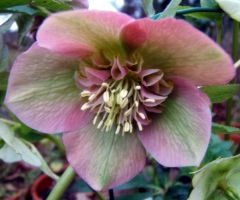 Interesting is to note here that I harvested an Anemone seedling from mQM ( open pollination ) and another one from a Picotee ( handpollinated cross of picotees but unprotected afterwards ).
Interesting is to note here that I harvested an Anemone seedling from mQM ( open pollination ) and another one from a Picotee ( handpollinated cross of picotees but unprotected afterwards ).The mQM seedling is of color Rose as the mother and the Doubling gen could only come from the White mWL or one of its seedlings , by assumption . In any case the doubling gen came from outside , with the bumblebees , I presume
The Picotee seedling is also Picotee as the mother . My knowledge on Picotee genetics is too low to come to a conclusion but either a Doubling gen is present within my Picotee collection ( not enough seedlings flowered until now ) either the gen did really come from the White mWL collection but without influencing the color .
End update 03/08
Going wild
A lot of people cross a lot of promising Hellebore to get special effects , this seems to me a good strategy for those who can only keep a small number of seedlings . Correct for a hobby but my goal is different , I prefer to know what I am doing if possible ..Another good question is to bring any kind of wild form in a breeding program . If the goal is to differentiate the gene pool and get a strong and healthy collection , just go for it ..
If you want more genetic information , then you get a philosophical problem because when you put a single wild plant in your garden you are making a garden plant of it ( wild plants are by definition in an infinite gene pool , garden plants are not )
DISPATCH HOME